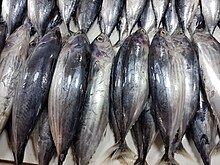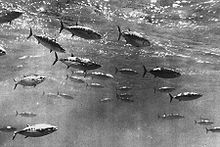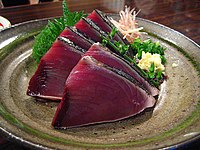
A tuna is a saltwater fish that belongs to the tribe Thunnini, a subgrouping of the Scombridae (mackerel) family. The Thunnini comprise 15 species across five genera, the sizes of which vary greatly, ranging from the bullet tuna up to the Atlantic bluefin tuna, which averages 2 m (6.6 ft) and is believed to live up to 50 years.

Katsuobushi is simmered, smoked and fermented skipjack tuna. It is also known as bonito flakes or broadly as okaka (おかか).
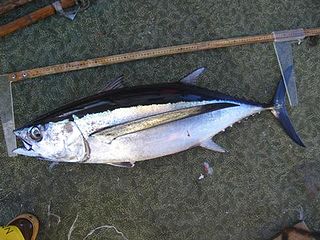
The albacore, known also as the longfin tuna, is a species of tuna of the order Scombriformes. It is found in temperate and tropical waters across the globe in the epipelagic and mesopelagic zones. There are six distinct stocks known globally in the Atlantic, Pacific, and Indian oceans, as well as the Mediterranean Sea. The albacore has an elongate, fusiform body with a conical snout, large eyes, and remarkably long pectoral fins. Its body is a deep blue dorsally and shades of silvery white ventrally. Individuals can reach up to 1.4 m in length.

Bonitos are a tribe of medium-sized, ray-finned predatory fish in the family Scombridae – a family it shares with the mackerel, tuna, and Spanish mackerel tribes, and also the butterfly kingfish. Also called the tribe Sardini, it consists of eight species across four genera; three of those four genera are monotypic, having a single species each. Bonitos closely resemble the skipjack tuna, which is often called a bonito, especially in Japanese contexts.

The yellowfin tuna is a species of tuna found in pelagic waters of tropical and subtropical oceans worldwide.
Felivaru Fisheries Maldives (FFM) is a company owned by the government of Maldives. It produces canned tuna and cooked fish for local and export markets.

A fish aggregatingdevice (FAD) is a man-made object used to attract pelagic fish such as marlin, tuna and mahi-mahi. They usually consist of buoys or floats tethered to the ocean floor. FADs attract fish for reasons that vary by species.

Poke is a dish of diced raw fish tossed in sauce and served either as an appetizer or a main course.

The Atlantic bonito is a large mackerel-like fish of the family Scombridae. It is common in shallow waters of the Atlantic Ocean, the Mediterranean Sea, and the Black Sea, where it is an important commercial and game fish.
The Maldives Industrial Fisheries Company, MIFCO, is a public company engaged in the production, processing and marketing of fish and fishery products. The company was incorporated in 1993.

The blackfin tuna is a species of tuna in the family Scombridae. It is occasionally referred to as the Bermuda tuna, blackfinned albacore, or deep bodied tunny. They are the smallest tuna species in the genus Thunnus, generally growing to a maximum of 100 cm (39 in) in length and weighing 21 kg (46 lb).

A fishing vessel is a boat or ship used to catch fish and other valuable nektonic aquatic animals in the sea, lake or river. Humans have used different kinds of surface vessels in commercial, artisanal and recreational fishing.

Maldives fish is cured tuna traditionally produced in Maldives. It is a staple of the Maldivian cuisine, Sri Lankan cuisine, and the cuisine of the Southern Indian states and territories of Lakshadweep, Kerala and Tamil Nadu, and in the past it was one of the main exports from Maldives to Sri Lanka, where it is known as umbalakaḍa (උම්බලකඩ) in Sinhala and masikaruvadu in Tamil. It is also produced in small scale using traditional methods in Lakshadweep Islands in India. It is known as massmin in Lakshadweep.

Two methods of preparing fish or meat in Japanese cuisine are called tataki or tosa-mi. In Japanese, tataki (たたき) means "pounded" or "hit into pieces".

The fishing industry in the Maldives is the island's second main industry. According to national tradition in the words of former President Maumoon Abdul Gayoom, "Fishing is the lifeblood of our nation, it is inborn. From the soil on which we live, to the sea around us, it remains an integral part of our existence. Fishing, and our country and its people, [are] one and shall remain inseparable forever." The Maldives has an abundance of aquatic life and species of fish. Common are tuna, groupers, dolphin fish, barracuda, rainbow runner, trevally and squirrelfish and many more. Aside from being of essential importance to the economy, fishing is also a popular recreational activity in the Maldives, not only among locals but by tourists. The islands have numerous fishing resorts which cater for these activities.

Cakalang fufu is a cured and smoked skipjack tuna clipped on a bamboo frame, a Minahasan delicacy of North Sulawesi, Indonesia.

Fishing is important to the national economy of Vanuatu. It is the main source of income for many in the islands and Vanuatu's biggest export. According to 2009 figures, approximately 77% of households in Vanuatu are involved in fishing activity. According to 2005 figures, Vanuatu caught 151,080 fish in that year, with frozen fish accounted for half of Vanuatu's commodity exports.
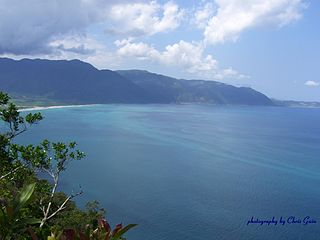
Pasaleng Bay, also Paselang Bay, is a bay on the north coast of Luzon island in the Philippines. It got its name from the border village of the same name located in the town of Pagudpud in the province of Ilocos Norte.

